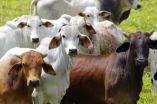(Press-News.org) Brazil may be able to curb up to 26% of global greenhouse gas emissions from deforestation by encouraging the intensification of its cattle production, according to a new study from researchers at the International Institute for Applied Systems Analysis (IIASA) and international collaborators.
The study, published in the journal Proceedings of the National Academy of Sciences, showed that by subsidizing semi-intensive pasture-based cattle production or taxing conventional pastures Brazil may be able to deliver a substantial cut in global greenhouse gas emissions, even in the absence of a global agreement to prevent deforestation.
Brazil is the world's second largest producer of beef and the world's largest exporter of beef. Cattle pastures occupy one quarter of the land surface in Brazil, including as much as 80% of recently deforested land. Brazil has lost more forestland than any other country in the past 20 years. Worldwide, deforestation contributes to as much as 20% of human-caused greenhouse gas emissions.
"Climate policies are an investment for governments. One of the major concerns that governments have about making climate policies unilaterally is that the benefits will be canceled out by increased emissions in other countries," says Tufts University researcher Avery Cohn, who led the study.
Previous studies of Brazilian agriculture have warned that policies to intensify cattle ranching could lower beef prices and increase beef consumption or raise beef prices and increase beef production. Either effect could drive more deforestation in other countries, canceling out any overall reduction in emissions.
"Our study shows that greenhouse gains from pasture intensification policies considerably exceed the losses. Brazil could act alone and still make a major dent in global greenhouse gas emissions," says IIASA researcher Aline Mosnier, a co-author on the study, which Cohn started as a participant in IIASA's Young Scientists Summer Program while completing his PhD at the University of California, Berkeley.
The two policies—subsidizing more intensive cattle ranching or taxing conventional pastures would both reduce deforestation in the Brazilian Amazon by about 50% between 2010 and 2030. This would lead to a 25% reduction in global greenhouse gas emissions from deforestation during that time. Combining the two policies could provide a revenue-neutral way for the Brazilian government to reduce greenhouse gas emissions.
The researchers expanded IIASA's Global Biosphere Management Model (GLOBIOM) to examine the effects of the two policies both within and beyond Brazil's borders. GLOBIOM is an economic model of global land use, which is being applied to questions of agriculture, deforestation, and REDD policies around the world.
Previous work by IIASA researchers has shown that more efficient livestock production methods could be an effective method to reduce greenhouse gas emissions worldwide, while improving food security. The new study was carried out in collaboration with Tufts University, the Energy Biosciences Institute (EBI) at the University of California, Berkeley, the Commonwealth Scientific and Industrial Research Organization (CSIRO), IIASA's Australian National Member Organization, and University of Natural Resources and Applied Life Sciences in (BOKU) in Vienna.
INFORMATION:
Reference
Cohn AS, Mosnier A, Havlik P, Valin, H, Herrerro M, Schmid E, O'Hare M, Obersteiner M. (2014). Cattle ranching intensification in Brazil can reduce global greenhouse gas emissions by sparing land from deforestation. Proceedings of the National Academy of Sciences. http://www.pnas.org/cgi/doi/10.1073/pnas.1307163111
For more information please contact:
Avery Cohn
Tufts University
Assistant Professor; the Fletcher School
Director; Program in Agriculture and Forests, Center for International Environment and Resource Policy
+1 (510) 410-3731
avery.cohn@tufts.edu
Aline Mosnier
Research Scholar
Ecosystems Services and Management
+43(0) 2236 807 567
mosnier@iiasa.ac.at
Katherine Leitzell
IIASA Press Office
Tel: +43 2236 807 316
Mob: +43 676 83 807 316
leitzell@iiasa.ac.at
About IIASA:
IIASA is an international scientific institute that conducts research into the critical issues of global environmental, economic, technological, and social change that we face in the twenty-first century. Our findings provide valuable options to policy makers to shape the future of our changing world. IIASA is independent and funded by scientific institutions in Africa, the Americas, Asia, Oceania, and Europe. http://www.iiasa.ac.at
Brazilian agricultural policy could cut global greenhouse gas emissions
2014-04-28
ELSE PRESS RELEASES FROM THIS DATE:
Oxytocin promotes social behavior in infant rhesus monkeys
2014-04-28
The hormone oxytocin appears to increase social behaviors in newborn rhesus monkeys, according to a study by researchers at the National Institutes of Health, the University of Parma in Italy, and the University of Massachusetts Amherst. The findings indicate that oxytocin is a promising candidate for new treatments for developmental disorders affecting social skills and bonding.
Oxytocin, a hormone produced by the pituitary gland, is involved in labor and birth and in the production of breast milk. Studies have shown that oxytocin also plays a role in parental bonding, ...
Scientists identify antibodies against deadly emerging disease
2014-04-28
Scientists at Dana-Farber Cancer Institute have identified natural human antibodies against the virus that causes Middle East Respiratory Syndrome (MERS), a step toward developing treatments for the newly emerging and often-fatal disease.
Currently there is no vaccine or antiviral treatment for MERS, a severe respiratory disease with a mortality rate of more than 40 percent that was first reported in Saudi Arabia in 2012.
In laboratory studies reported in the Proceedings of the National Academy of Sciences (PNAS), the researchers found that these "neutralizing" antibodies ...
Study: Tart cherry juice increases sleep time in adults with insomnia
2014-04-28
SAN DIEGO, Calif. April 28, 2014 – A morning and evening ritual of tart cherry juice may help you sleep better at night, suggests a new study presented today at the Experimental Biology 2014 meeting. Researchers from Louisiana State University found that drinking Montmorency tart cherry juice twice a day for two weeks helped increase sleep time by nearly 90 minutes among older adults with insomnia.
These findings were presented Monday, April 28, at the "Dietary Bioactive Components: Antioxidant and Anti-inflammatory Effects of Dietary Bioactive Components" section of ...
Decrease in large wildlife drives an increase in rodent-borne disease and risk to humans
2014-04-28
Populations of large wildlife are declining around the world, while zoonotic diseases (those transmitted from animals to humans) are on the rise. A team of Smithsonian scientists and colleagues have discovered a possible link between the two. They found that in East Africa, the loss of large wildlife directly correlated with a significant increase in rodents, which often carry disease-causing bacteria dangerous to humans. The team's research is published in the Proceedings of the National Academy of Sciences, April 28.
"Our study shows us that ecosystem health, wildlife ...
Smart home programming: Easy as 'if this, then that'
2014-04-28
PROVIDENCE, R.I. [Brown University] — The idea of a smart home sounds promising enough. Who doesn't want a house full of automated gadgets — from light switches to appliances to heating systems — that know exactly when to turn on, turn off, heat up or power down?
But in order for all those devices to do what they're supposed to do, they'll need to be programed — a task the average homeowner might not have the interest or the tech-savvy to perform. And nobody wants to call tech support just to turn on a light.
A group of computer science researchers from Brown and Carnegie ...
Satellite movie shows US tornado outbreak from space
2014-04-28
VIDEO:
This animation of NOAA's GOES-East satellite data shows the development and movement of the weather system that spawned tornadoes affecting seven central and southern US states on Apr. 27-28, 2014....
Click here for more information.
NASA has just released an animation of visible and infrared satellite data from NOAA's GOES-East satellite that shows the development and movement of the weather system that spawned tornadoes affecting seven central and southern U.S. states ...
NIH scientists establish monkey model of hantavirus disease
2014-04-28
WHAT: National Institutes of Health (NIH) researchers have developed an animal model of human hantavirus pulmonary syndrome (HPS) in rhesus macaques, an advance that may lead to treatments, vaccines and improved methods of diagnosing the disease. The study, conducted by researchers at NIH’s National Institute of Allergy and Infectious Diseases (NIAID), is published in the Proceedings of the National Academy of Sciences.
People become infected with hantaviruses by inhaling virus from the urine, droppings or saliva of infected rodents. This infection can progress to HPS, ...
A water test for the world
2014-04-28
HAMILTON, April 28, 2014 – Inspiration can come in many forms, but this one truly was a breath of fresh air.
A group of McMaster researchers has solved the problem of cumbersome, expensive and painfully slow water-testing by turning the process upside-down.
Instead of shipping water to the lab, they have created a way to take the lab to the water, putting potentially life-saving technology into the hands of everyday people.
The team has reduced the sophisticated chemistry required for testing water safety to a simple pill, by adapting technology found in a dissolving ...
Technological advancements extend survival of transplanted hearts across species
2014-04-28
The use of transplant organs from animals (xenotransplantation) could help to compensate for the shortage of human organs available for transplant. NIH researchers have demonstrated that by using hearts from genetically engineered pigs in combination with target-specific immunosuppression of recipient baboons, organ survival can be significantly prolonged. This has potential for paving the way for the use of animal organs for transplantation into humans.
Toronto, ON, Canada, April 28, 2014 – Cardiac transplantation is the treatment of choice for end stage heart failure. ...
Disney Researchers use 3-D printing to produce interactive speakers of any shape
2014-04-28
Forget everything you know about what a loudspeaker should look like. Scientists at Disney Research, Pittsburgh have developed methods using a 3D printer to produce electrostatic loudspeakers that can take the shape of anything, from a rubber ducky to an abstract spiral.
The simple speakers require little assembly, but even those few manual steps might be eliminated in the future, said Yoshio Ishiguro, a Disney Research, Pittsburgh post-doctoral associate. "In five to 10 years, a 3D printer capable of using conductive materials could create the entire piece," he predicted.
The ...






